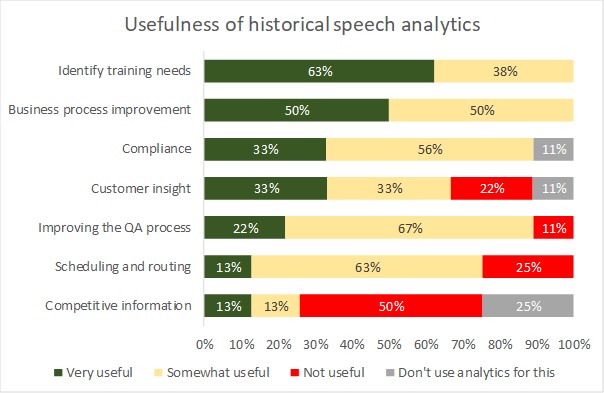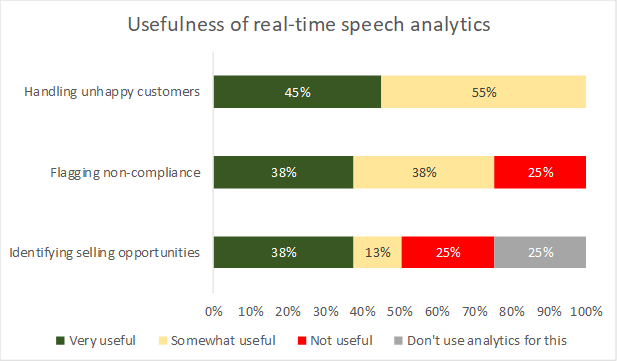Speech analytics can
be used in many different ways in the contact centre to address numerous customer
experience and operational issues. This is an advantage - it is hugely flexible
- but it can also make its message to potential users more complicated. Like
most contact centre applications, analytics can be used to cut costs, but its
promise goes far beyond this, including:
- agent improvement and quality assurance
- business process optimisation
- avoidance of litigation and fines
- customer satisfaction and experience improvements
- increases in revenue and profitability
- improvements in contact centre operational performance.
Analytics comes in
many flavours – historical speech analytics, real-time speech analytics, multichannel
analytics, desktop analytics, text analytics, customer journey analytics and back
office analytics – in this article, we’ll look at what users of historical and real-time
speech analytics find it most useful for.
Historical speech analytics
Initial
implementations of speech analytics solutions were focused upon analysing large
numbers of recorded calls, often a long time after the actual event. Many of
the original users purchased these solutions to assist them with compliance and
as part of a larger quality assurance system, and these benefits have not
decreased over time. Being able to analyse 100% of calls automatically can
provide high quality information for the QA process, giving a fair and accurate
reflection of the agent’s performance.
While there is real
and growing interest in real-time analytics, historical speech analytics is
still vital for business intelligence, performance improvement, QA and
compliance. As the majority of contact centres have call recording in place,
the raw material is already available. In fact, the amount of recorded voice
data available to most businesses can be overwhelming, and historical speech
analytics that analyse 100% of recorded calls is proving hugely valuable.

The automated
quantification of agent performance and capabilities, feeding into the training
and skills upgrades required should be one of the most important outputs for
interaction analytics, and 63% of respondents state that analytics is very
useful for this purpose. However, only 22% indicate that analytics is very
useful for speeding up the overall quality monitoring process as well through
automation.
50% of analytics users
state that it is very useful identifying improvements to business processes. Optimising
processes and gaining actionable insight that can be applied to the customer
journey will become one of the most important uses of analytics, as users’
sophistication increases and solutions’ capabilities are explored more fully.
There is little real
enthusiasm around the use of analytics for providing information about their
competitors. This is a very underused area of analytical usage at the moment,
and one which we would again expect to see growing significantly in future
years.
Few respondents have
found that analytics particularly helps influence scheduling or routing
strategies, but as more tightly-integrated WFO suites are used, we would expect
this to change for the better.
The
chart above does not provide an exhaustive list of the purposes of interaction
analytics: specific business requirements and original considerations about
customer contact can provide numerous ways in which greater insight can be
extracted from the mass of interactions stored, for example, understanding
fully why customers have called, rather than relying on agent call disposition
codes.
Real-time speech analytics
Real-time analytics can be used in many ways:
- monitoring calls for key words and phrases, which can either be acted upon within the conversation, or passed to another department (e.g. Marketing, if the customer indicates something relevant to other products or services sold by the company)
- alerting the agent or supervisor if pre-specified words or phrases occur
- offering guidance to the agent on the next best action for them to take, bringing in CRM data and knowledge bases to suggest answers to the question being asked, or advice on whether to change the tone or speed of the conversation
- escalating calls to a supervisor as appropriate
- detecting negative sentiment through instances of talk-over, negative language, obscenities, increased speaking volume etc., that can be escalated to a supervisor
- triggering back-office processes and opening agent desktop screens depending on call events. For example, the statement of a product name or serial number within the conversation can open an agent assistant screen that is relevant to that product
- making sure that all required words and phrases have been used, e.g. in the case of compliance or forming a phone-based contract
- suggesting cross-selling or upselling opportunities.

Real-time offers a big step up from the traditional, manual call monitoring process, and is particularly useful for compliance, debt collection, and for forming legally-binding contracts on the phone, where specific terms and phrases must be used and any deviation or absence can be flagged to the agent's screen within the call.
The speed of real-time is crucial to its success: long delays can mean missed, inappropriate or sub-optimal sales opportunities being presented; cancellation alerts can show up too late; compliance violations over parts of the script missed-out may occur as the call has already ended. However, it is important not to get carried away with real-time, as there is a danger that businesses can get too enthusiastic and set alert thresholds far too low. This can result in agents being constantly bombarded with cross-selling and upselling offers and/or warnings about customer sentiment or their own communication style, so that it becomes a distraction rather than a help.
The
effectiveness of real-time may be boosted by post-call analytics taking place
as well. For example, by assessing the outcomes of calls where specific
cross-selling and upselling approaches were identified and presented to agents
in real time, analysis can show the most successful approaches including the
use of specific language, customer type, the order of presented offers and many
other variables (including metadata from agent desktop applications) in order
to fine-tune the approach in the future.
However, the users of real-time speech analytics are somewhat less positive about its usefulness for boosting commercial opportunities. While identifying unhappy customers is seen positively, this is something that a well-trained and empathetic agent should be able to do for themselves. The advent of AI-enabled real-time analytics will act as a supervisor in every agent's ear, guiding and encouraging them to make the best of any opportunity that presents itself.